Pasta is a product that is loved all over the world! This is a delicious, nutritious meal that is also prepared in minutes. And how many delicious things can be made using them! There are hundreds of variations of one pasta, for example, the famous one. But there are also soups, casseroles, and just...
But if you don’t know how to cook pasta correctly, you’re unlikely to experience all the benefits of this wonderful product. And although at first glance this is a simple procedure, there are still nuances and features that simply must be taken into account if you want to prepare the perfect meal.
How to cook pasta correctly
The easiest way to cook pasta so that it does not stick together, does not spread, and turns out crumbly is to follow the instructions that are on each package. The most valuable thing there is the cooking time.
The step-by-step universal scheme looks like this:
- take a sufficient amount of water into the pan, bring to a boil, add salt;
- add, stirring, the required amount of noodles or paste;
- Wait for it to boil again, reduce the heat to low and cook until tender.
But you need to take into account that the pan should be voluminous and convenient, since the ideal proportions of water, pasta and salt in grams look like this - 1000:100:10. 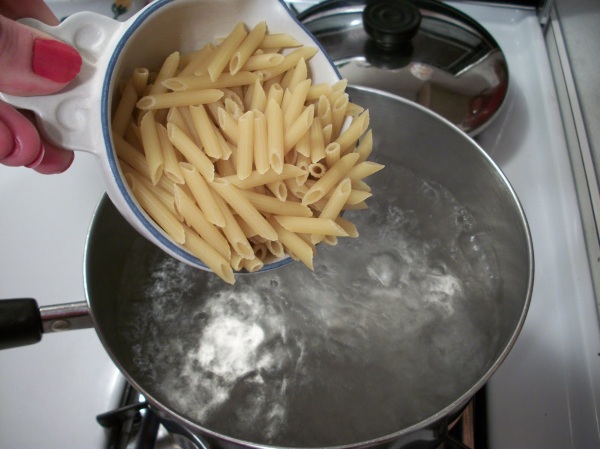
By the way, according to chef standards, a serving for 1 person is 100 g of pasta. That is, if lunch is planned for 4, the volume of the pan should be at least 5 liters.
I always measure the amount of pasta before cooking using a food scale. If dinner is for two, then I boil 200 g of pasta side dish. This is the perfect portion.
Therefore, in packages with Italian pasta, the weight is always a multiple of 100 g. But domestic manufacturers, as usual, are cunning, sometimes producing packages of 450 g.
After boiling, actions may vary. It is considered correct to simply drain the pasta, add a knob of butter and serve. But this applies only to those products that are made from durum wheat or whole grain flour. If this is ordinary simple noodles made from soft varieties of wheat, then we cannot do without rinsing with cold water, as well as subsequent frying with some kind of fat, otherwise we will get a slippery sticky lump.
How long you will cook also depends on the type of pasta, the type of flour from which it is made, as well as the dish for which it is intended.
Cooking pasta from durum wheat
Let's start with the most popular and healthy - pasta made from durum wheat. They contain a lot of vitamins, complex carbohydrates and microelements. The shapes and sizes are very diverse - horns, spirals, noodles, butterflies, shells and long spaghetti. And this is if you don’t take into account the Italian variety with their cannelloni, tagliatelle, etc. 
Almost all of them are cooked according to the standard scheme from 8 to 12 minutes. At the 8th minute it’s better to start trying, because everyone has their own preferences. In general, as you know, in the homeland of pasta, those that are cooked “al dente” are considered ideal.
Al Dente translates to “by the tooth,” that is, the degree of readiness is such that the pasta itself is already soft, but still springs when bitten.
Let’s focus separately on such types as spaghetti and nests - they are a little more difficult to cook. The secret to cooking long spaghetti is to lower it into boiling water gradually until all of it is submerged. Then the whole process proceeds as with any other 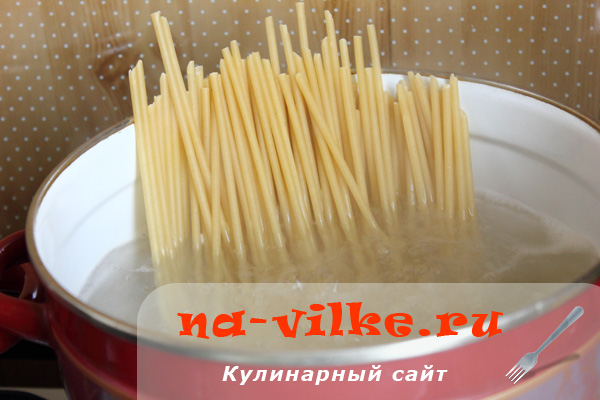
Nests should be cooked in a wide, voluminous container - ideally a frying pan with high sides or a saucepan. There should be enough boiling water so that the “nest” is completely covered. Place the pasta balls in boiling and salted water so that they do not touch each other. You can’t interfere - you can move it a little. We carefully remove the finished ones with a slotted spoon.
How to cook whole grain pasta
Whole grain pasta is also very healthy, but due to its gray-brown color it looks less appetizing. Boil them for 7-10 minutes, and then, if desired, you can simply drain them in a colander and, season with oil, serve. 
Or you can rinse it and then warm it up with some sauce. For example, classic will perfectly complement the taste and aroma of the dish.
Cooking plain pasta
Pasta products made from soft wheat are inferior in health to those listed above, and a real gourmet will never buy such pasta. But this product is often found in the average person’s kitchen. For example, I really love vermicelli. 
A side dish of such pasta is prepared with obligatory subsequent rinsing under cold running water. You need to cook them for no more than 7 minutes. I personally make it even simpler:
- I throw vermicelli into boiling water;
- I stir, waiting for the water to boil again;
- cover with a lid and turn off the heat completely - this won’t work with the lid open;
- After 3-4 minutes I stir again, and after another 4-5 I drain the water and rinse.
I like this method because the noodles themselves do not stick to the pan, do not stick together, do not try to “run away,” and even if you miss a few minutes, they do not boil “into mush.”
A little exotic pasta
Non-standard types of pasta have also appeared in large supermarkets - buckwheat, rye, etc. Particularly popular are Asian rice pasta, which is prepared in the same way, but takes about 5 minutes to cook.
Bright colored butterflies or spirals made of durum wheat, as well as black pasta, also look unusual. Cooking them is no different from the standard scheme, but when choosing, make sure that the dyes are natural (spinach, beet juice, turmeric, etc.), otherwise there will be no benefit, and all the dishes will be stained. 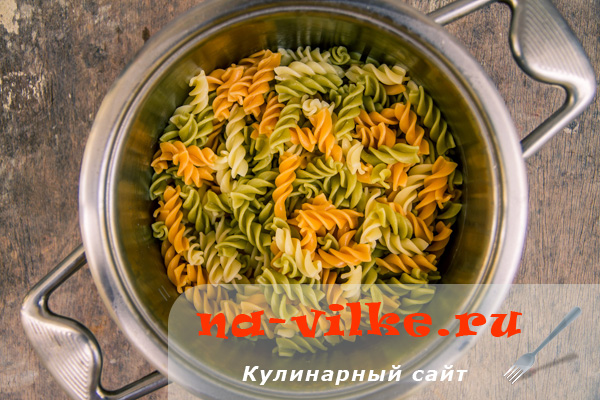
Any pasta or noodles will taste better if you add a piece of butter or 1 tbsp to the water during cooking. olive
Cook in a slow cooker, steamer or microwave
To prepare pasta, you can use not only pots, saucepans or frying pans - modern kitchen devices can also cope with this task.
The easiest way to do this is in the microwave. We choose suitable dishes, preferably with a lid and holes, and always high - otherwise the water will leak out. Fill the pasta with water in a ratio of 1:2, set the power to the highest and turn it off after 7-9 minutes. Stir, let it brew for 2-3 minutes, drain the water and the side dish is ready. You can sprinkle with grated cheese and microwave for another minute. 
We cook in a slow cooker according to the same principle as in a saucepan - throw it into boiling water, cook for about 10 minutes, don’t forget to stir. It's important to choose correct mode– the water should not flow during cooking. Focus on the features of a specific model.
It is better to cook pasta from hard varieties in a double boiler, as the rest will simply stick together. This is done like this: pour a sufficient amount of water into the lower bowl, pour pasta into the upper bowl (use a container for cooking rice), fill it with water, add salt and cook until tender. It will take 3-4 minutes longer than with the usual method.
Secrets of cooking popular pasta dishes
Pasta is not only used as a side dish, so you need to know the cooking features for certain dishes:
- For preparing broth-based soups, small pasta is suitable, which must be thrown into boiling liquid 8-10 minutes before the end of cooking;
- milk soups with noodles will be more tasty if you first boil the pasta in Not large quantities water until half cooked, and then just pour in the boiled milk and bring to the desired condition over low heat;
- the simplest dish - pasta with stew - will turn out perfect if the pasta is cooked al dente, and after adding meat, it is kept for another 10-15 minutes over low heat;
- for lasagna, the sheets are not boiled if the amount of sauce covers all ingredients by at least 0.5 cm, in otherwise It is better to pre-cook for 1-2 minutes.
Or you can not just boil the pasta, but cook it boiled and fried - it turns out quite interesting, especially if you add grated cheese at the end. You can learn how to do this from the video:
Every national cuisine includes pasta dishes, and they are very popular among the population. Except they have different names. In Italy, all pasta is pasta. In Asia, it is more common to call pasta “kespe”, while Russians prefer the word “noodles”.
But no matter what this product is called, it is always cooked according to long-established rules. After all, if you don’t adhere to them, then instead delicious pasta you can end up with an unsightly mess.
The main requirement that must be strictly adhered to is related to the proportions of water and pasta.
How much water to pour into the pan for cooking pasta?
To ensure that the pasta is cooked evenly and turns out elastic and tasty, use at least 1 liter of water per 100 g of product for cooking it. Therefore, if you need to cook a large amount of pasta, then take a large pan.
Before putting noodles or vermicelli in it, water is salted, using approximately 8 g of salt per 1 liter of liquid.
Some housewives add a spoon to the water vegetable oil. This improves the taste of the pasta and prevents it from sticking slightly.
What heat should you use to cook pasta?
In order for pasta to fully reveal its taste and nutritional qualities and at the same time not be burdensome for the stomach, they are cooked at a sufficient boil, but the water should not boil too much.
It is important that the liquid boils again as quickly as possible after immersing the pasta in it.
Do not cover the pan with a lid during cooking.
To prevent horns, noodles or other products from sticking to the bottom and sticking together during cooking, they are periodically carefully stirred.
How long should you cook pasta in a saucepan?
There is no clear answer to this question. After all, a lot depends on the quality of the flour, the kneading of the dough, the number of eggs or, conversely, their absence, and even on how long ago the pasta was made.
For example, egg noodles, which the hostess rolled out a few hours ago, will be cooked quickly - in 5 minutes. But store-bought will take a little longer to cook.
If the pasta was made from durum flour, then they hold their shape well when cooked, do not become soft, do not become soggy and do not stick together after they are placed in a colander.
The cooking time also depends on the type of pasta. After all, horns or feathers take much longer to cook than vermicelli. Therefore, before cooking, be sure to read the information on the packaging. But if pasta is sold by weight, then it is cooked by the tooth.
Do I need to rinse pasta?
It is not customary to wash pasta.
Immediately after boiling, place them in a colander and wait until all the broth has drained.
Then they are returned to the pan and oil is immediately added there. It can be butter, ghee, vegetable oil, lard or margarine. It all depends on the preferences of the hostess and on the recipe of the chosen dish.
Only this recommendation applies to pasta made from durum wheat. But most often housewives buy cheap horns or noodles, which are made from flour of other types of wheat. If such pasta is not washed, it will stick together into one big lump.
Therefore, in each individual case, the housewife herself decides whether to rinse what she has cooked or not.
However, some countries have their own rules about this. In Asian cuisine, thin noodles and lagman - thick, long noodles - are most often prepared. They are cooked according to the same principle - in a large amount of water until cooked. But lagman, unlike Italian pasta, must be washed in cold water and greased with oil.
Before placing it on plates, it is heated by placing it directly in a colander in hot water, and then waiting for it to drain. Do the same with noodles.
How to determine whether pasta is ready
Most often, the housewife relies on her taste, intuition and experience.
But the Italians, for example, have their own method for determining the readiness of pasta.
They cook any pasta until it is “al dente”, that is, “to the tooth”.
Ready-made pasta should never be overcooked. Properly welded products do not get stuck in the teeth, but lag behind them.
But you need to remember that boiled hot pasta, once back in the pan after draining the water, continues to ripen for some time, so even slightly overcooked noodles will become soggy and stick together.
If pasta is needed for a casserole, boil it until tender, drain the water, mix with butter, place in a mold and bake. For casseroles, it is better to take pasta made from soft varieties of wheat, but for a side dish, products made exclusively from hard varieties are suitable.
How to cook pasta in the microwave
A microwave oven is used for more than just heating food. You can even cook noodles in it.
Cooking conditions in the microwave are the same as on the stove. That is, pasta is cooked in a large amount of liquid. For example, 200 g of pasta will require 3 liters of water. But the bookmark sequence is different.
- Place pasta in the pan.
- Pour boiling salted water so that it covers the products by 4-5 cm.
- Cover the dish with a lid, leaving room for steam to escape.
- Cook at maximum power for about 7 minutes.
- Turn off the microwave oven.
- Leave the pasta in the water for another 7-10 minutes.
- The water is drained.
- Boiled pasta is brushed with butter or topped with gravy.
How to cook pasta in a slow cooker
When cooking in a slow cooker, it is better to use pasta made from durum wheat, otherwise the result may be unpredictable. But if, nevertheless, the noodles do not meet these requirements and are made from soft varieties of wheat, then they are cooked in this way:
- Pour water into the bowl and let it boil on any program.
- Add a little vegetable or butter and salt to taste.
- Put in pasta. Make sure that the water completely covers them.
- Stir.
- Close the lid and cook for 10 to 20 minutes, depending on the type and type of noodles, setting the “Steam” or “Pilaf” program.
If the pasta is made from durum wheat, then it can be cooked differently.
- Place pasta in the bowl.
- Pour in cold salted water until it completely covers them.
- Don't mix.
- Close the lid and cook, setting the “Steam” or “Pilaf” function.
How to cook pasta soup
For soup, noodles or vermicelli are most often used.
Since this pasta cooks very quickly, it is added at the very end, when the soup is almost ready.
Considering the duration of cooking the noodles, they are added 7-10 minutes before the end of cooking. But you need to remember that, while in a hot broth, the noodles continue to cook, even if the pan has already been removed from the stove. Therefore, it is recommended to undercook pasta slightly. The soup is allowed to brew for a few minutes and poured into bowls.
Many people refuse to eat pasta for fear of gaining weight. But to prevent this from happening, dishes with such products are prepared in such a way that the amount of horns or noodles is three times less than vegetables.
After all, it is carrots, onions, cabbage, eggplants, peppers and various greens that make pasta dishes very tasty, never boring and healthy.
You also need to use pasta made from durum wheat for food, and then dishes made from it will not cause weight gain. How to choose such pasta:
- The packaging of products made from durum wheat is marked “Group A”.
- There should be no crumbs or flour at the bottom of the package.
- These pasta are amber-golden in color.
- When cooked, they do not lose their shape, do not become soft and do not stick together.
- Spaghetti made from durum wheat is difficult to break and has a glassy fracture.
Pasta is a fairly simple and very tasty dish. Properly prepared, they are good both on their own and in a variety of combinations. It seems that anyone can figure out how to boil pasta in a slow cooker or how to make it in a regular saucepan, but there are still certain subtleties that ensure truly good taste. For example, an important condition for success is choosing the right pan. So, let's figure out how to boil pasta deliciously. Here are some secrets.
Start by selecting the dishes. In order to cook two hundred grams of pasta, you need a saucepan with a volume of at least two liters. If you forget about this condition, even the best quality pasta will turn out sticky and unpleasant in texture. You only need to pour them into already boiled water and immediately after that mix thoroughly. Cover the pan with a lid, wait until the water boils again, then reduce the heat and remove the lid. This will prevent the pasta from flooding the stove. It should take about ten minutes to cook, see the packaging for details. If you plan to cook them later, do not cook them until fully cooked. You should not pour out all the water from the finished dish, as after a while they will completely dry out.  It is better to drain the pasta from the pan in a colander, leaving a couple of tablespoons of water in it, and then place the finished product in the pan. If you want to have an Italian-style dinner, keep in mind that pasta should be served hot and on heated plates. You need to select the sauce before boiling the pasta. After they are cooked, do not rinse them with water - the idea that it will turn out tastier this way is completely wrong.
It is better to drain the pasta from the pan in a colander, leaving a couple of tablespoons of water in it, and then place the finished product in the pan. If you want to have an Italian-style dinner, keep in mind that pasta should be served hot and on heated plates. You need to select the sauce before boiling the pasta. After they are cooked, do not rinse them with water - the idea that it will turn out tastier this way is completely wrong.
What to cook with pasta?
So, everything is more or less clear on how to boil pasta. Let's look at one more task - recipes using them. There can be a whole lot of options, it all depends on what you like.  Pasta is combined with meat, chicken, seafood, any type of cheese, mushrooms and various vegetables, so you can limit the list only to the possibilities of your own imagination. First, try cooking simplest option- pasta with egg. Even a schoolchild can cope with this dish. You already know how to boil pasta, so this won’t be a problem. It is only important to choose a quality product. It is best to opt for products made from durum wheat, which have a more pleasant taste and dense texture. Do not overcook them - the packaging must contain recommendations from the manufacturer, so it is enough to follow the advice. Once they are ready, fry in a greased frying pan with an egg and any seasoning to taste. A couple of minutes is enough for the egg to stop being raw. You can also add tomatoes or mushrooms during the frying process, and maybe even ham or meatballs. You can eat the finished dish with ketchup or other favorite sauce, however, just like that, it also turns out very, very tasty.
Pasta is combined with meat, chicken, seafood, any type of cheese, mushrooms and various vegetables, so you can limit the list only to the possibilities of your own imagination. First, try cooking simplest option- pasta with egg. Even a schoolchild can cope with this dish. You already know how to boil pasta, so this won’t be a problem. It is only important to choose a quality product. It is best to opt for products made from durum wheat, which have a more pleasant taste and dense texture. Do not overcook them - the packaging must contain recommendations from the manufacturer, so it is enough to follow the advice. Once they are ready, fry in a greased frying pan with an egg and any seasoning to taste. A couple of minutes is enough for the egg to stop being raw. You can also add tomatoes or mushrooms during the frying process, and maybe even ham or meatballs. You can eat the finished dish with ketchup or other favorite sauce, however, just like that, it also turns out very, very tasty.
Pasta is a dish that everyone loves. They are tasty, nutritious and quite easy to prepare. However, to get a truly tasty dish, it’s not enough to just cook the pasta. You need to cook them well, because even the recipe delicious dish You can ruin it if you don’t know how to cook pasta correctly.
In addition, in order not to be disappointed with the result of cooking, pasta should be different good quality. Therefore, the success of the cooking result depends on the right choice pasta
The highest quality and tastiest pasta is made from durum wheat. And although such pasta is more expensive, rest assured that it will not stick together or fall apart during cooking. In addition, unlike pasta made from white flour, they are healthy and can be consumed even by those watching their weight.
Pasta made from durum wheat is a real storehouse of healthy carbohydrates, which are classified as complex carbohydrates, thanks to which the human body is provided with energy for a long time. In addition, when consuming a reasonable amount of this product, the body will receive a number of vitamins and substances necessary for health. These products contain virtually no sodium, which is known to cause aging.
Choosing the right one
When choosing pasta in a store, pay attention to their appearance. To get a better look at the product, choose transparent packaging. A quality product is distinguished by a smooth surface, a clean glassy cut and a creamy or golden hue. A product with a whitish or yellowish tint and a rough surface can be classified as low-quality. Also, there should be no flour dust in the bag. In addition, when purchasing, it is important to look at the composition of the product indicated on the packaging. Quality pasta contains only flour and water. In rare cases, eggs are added.
If you prefer colored pasta, be sure to color it using natural dyes. Also check the packaging for integrity. If it is damaged, the products may absorb moisture, and this negatively affects their quality. And, of course, be sure to pay attention to the expiration date of the product.
Golden rules for preparing traditional types of pasta
To cook pasta well, you must adhere to the following time-tested rules:

The above information on how to cook pasta applies to such common and beloved products as horns, shells, noodles, feathers, spaghetti. Wherein long products(spaghetti) should not be broken into smaller pieces. It will be enough to simply press a little on them to immerse them in water. During the cooking process they will soften, after which it will be convenient to distribute them around the perimeter of the pan.
Alternative ways to cook pasta
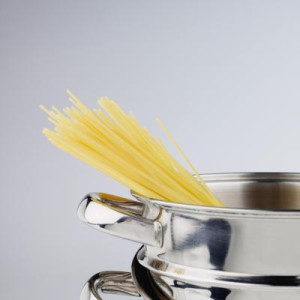
Today, pasta can be cooked in other, more modern and convenient ways, requiring neither stirring nor monitoring the fire level:
- in the microwave;
- in a slow cooker;
- in a steamer.
For products in the microwave, the amount of water should be twice the amount of pasta, that is, for 0.1 kg of dry product you need to take at least 0.2 liters of liquid. A glass pan of water is placed in the microwave until it boils. Next the pasta is added. It is important to ensure that the pasta is completely covered with water. Then add salt and vegetable oil (1 tbsp.). Pasta is cooked in the microwave in a closed container for an average of about 10 minutes at a power of 500 W. It should be taken into account that these parameters are optimal for preparing horns, feathers or shells. When cooking smaller and thinner products, you need to reduce the time or reduce the power.
When used for cooking, the water level in the pan should be 2-3 cm higher than the level of the pasta. Add butter to the pasta (about 1 tablespoon). Pasta is prepared for about 12 minutes using the “pilaf” or “steaming” mode. Some housewives, to simplify the process of preparing dinner, prepare another dish (for example, sausages or pieces of chicken fillet) at the same time as pasta using a special steaming tray.
When cooking pasta in a steamer, pour it into a rice bowl and fill it with water. The water level should be about two centimeters higher than the pasta level. To avoid sticking, also pour a spoonful of vegetable oil into the bowl and add salt. The pasta is cooked for about 15 minutes under the lid.
Making pasta nests
Nowadays nest pasta is very popular, from which you can prepare many different dishes. They are prepared slightly differently than the types of pasta we are used to. Knowing how to cook pasta in the form of nests correctly, you can avoid them falling apart. To ensure that they keep their shape during cooking, the nests are prepared in a frying pan with high sides or in a saucepan with a wide bottom. The pasta nests should be laid out in one layer, leaving small spaces between them. Next, boiling water is poured in just enough to cover the nests. When the water boils, add salt and a little vegetable oil. Cook with the lid closed over moderate heat for the time indicated on the package or a couple of minutes less to obtain firmer pasta. Ready pasta nests Place on a plate with a slotted spoon and fill with filling if desired.
One of the most popular side dishes in Russia. Boiled pasta is served with goulash, cutlets, and other dishes.
Cooking pasta is very simple. It is important not to overcook them - this is the main mistake when preparing them. Most often, housewives taste the doneness, and then begin to remove the pan from the stove, drain the water, and so on. And they completely ignore the fact that in this half a minute the already prepared pasta has time to be digested.
Carefully study the cooking method indicated on the package of pasta. All these products are tested by manufacturers. And the cooking time is always written on the package. And it is always different. And it is this difference, some 2-3 minutes, that is very important.
Our advice is to reduce the specified cooking time by exactly one minute. Then you will get perfectly cooked pasta.
The pasta cooking time should be counted from the water boiling again. But only on the condition that the proportions of water and pasta are correct.
So, pour 2 liters of water into the pan.
Season with 2 teaspoons salt. 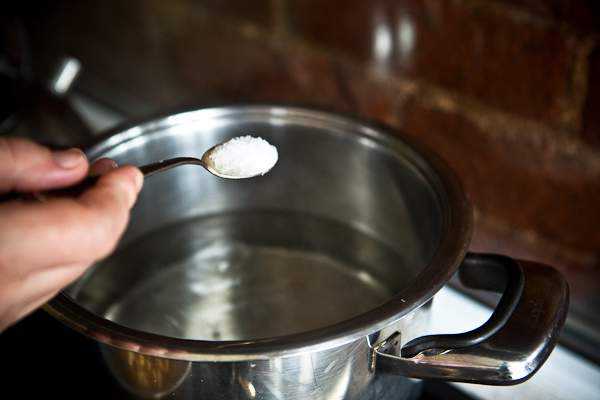
Bring the water to a boil.
Add the pasta and stir immediately. 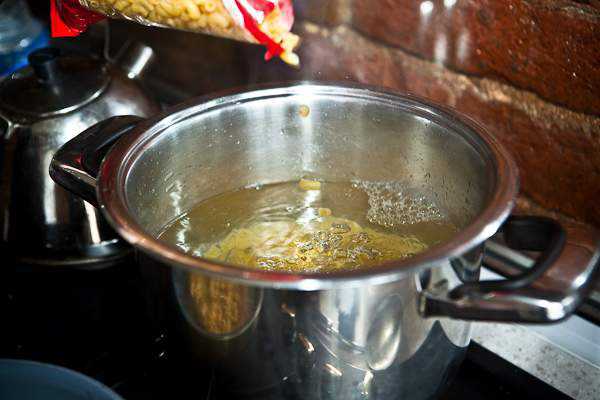
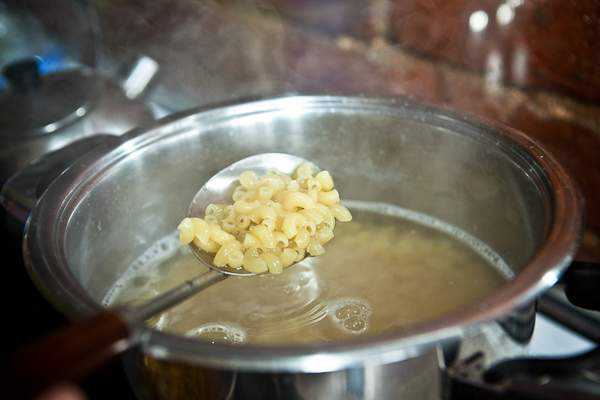
As soon as the water boils, immediately begin counting down the cooking time. And be sure to stir the pasta again when the water boils. 
Cook them for 5-7 minutes (cooking time indicated on the package minus one minute).
Then drain the pasta in a colander and let the water drain. 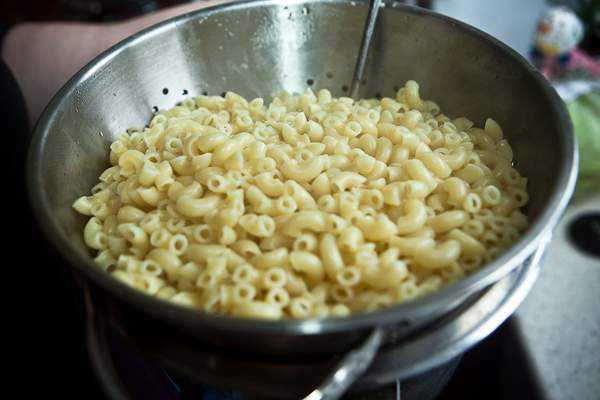
Modern pasta does not require rinsing. Since they are now made using other technologies and from durum flour.
So just drain the water (1-2 minutes).
And transfer the pasta back to the warm pan. 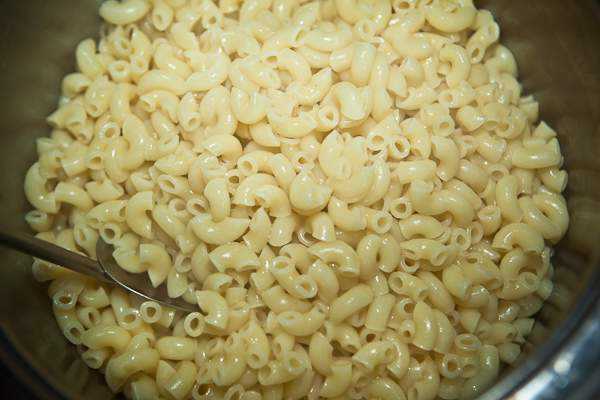
Add butter and cover the pan with a lid. 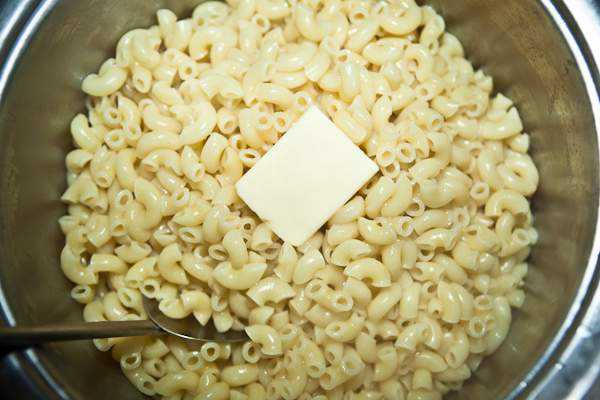
After a minute, remove the lid (the butter should melt). Stir the pasta itself again. 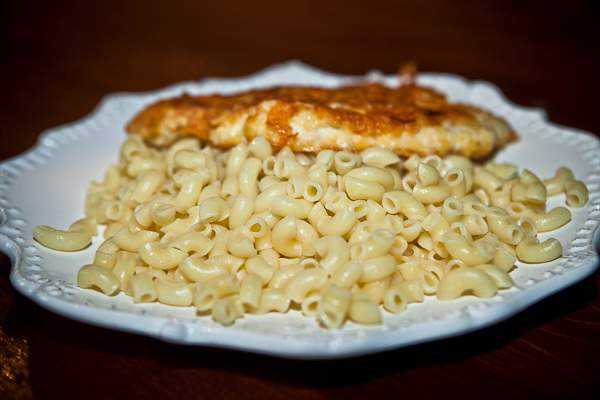
Ready!









